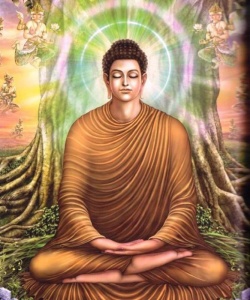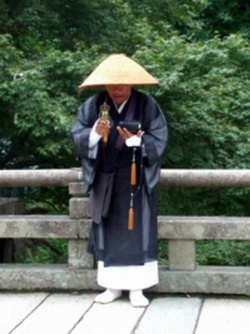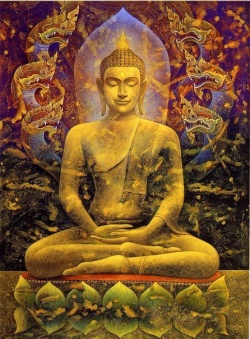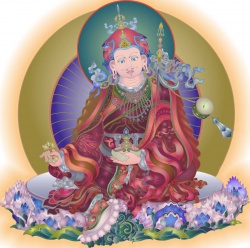Seven Point Mind Training
Prostration to great compassion.
Point One: The Preliminaries
Train first in the preliminaries precious human rebirth, death and impermanence, behavioral cause and effect, the disadvantages of samsara.
Point Two: The Actual Training in Bodhichitta
Training in Deepest Bodhichitta
Ponder that phenomena are like a dream. Discern the basic nature of awareness that has no arising. The opponent itself liberates itself in its own place. The essential nature of the path is to settle within a state of the all-encompassing basis. Between sessions, act like an illusory person.
Training in Conventional Bodhichitta
Train in both giving and taking in alternation, mounting those two on the breath.
(In regard to) the three objects [those beings whom I find attractive, unattractive, or neutral, (take) the three poisonous attitudes longing desire, repulsion, or naivety] and (give) the three roots of what’s constructive detachment, imperturbability, or lack of naivety], (while) training with words in all paths of behavior.
As for the order of taking, start from myself.
Point Three: Transforming Adverse Circumstances into a Path to Enlightenment
Transforming with Our Thoughts Concerning Our Behavior
When the environment and its dwellers are full of negative forces, transform adverse conditions into a path to enlightenment, by banishing one thing [my self-cherishing attitude as (bearing) all blame and meditating with great kindness toward everyone.
Transforming with Our Thoughts Concerning Our View
Voidness, from meditating on deceptive appearances as the four Buddha-bodies, is the peerless protector.
Transforming with Our Actions
The supreme method entails four actions to use, [(1) building up positive force, (2) purifying myself of negative force, (3) making offerings to harmful spirits, and (4) requesting the enlightening influence of the Dharma protectors. (So) instantly apply to meditation whatever I might happen to meet.
Point Four: Condensation of the Practice in One Lifetime
During Our Lifetime
In brief, the essence of the quintessence teachings is applying the five forces
[(1) intention,
(2) white seed,
(3) habituation,
(4) eliminating all at once, and
(5) prayer.
The quintessence teaching for the Mahayana transference of mind is the five forces themselves, while giving importance to my path of deportment.
Point Five: The Measure of Having Trained Our Minds
If all my Dharma practice gathers into one intention [to eliminate self-cherishing]
If, from the two witnesses [others and myself], I take [myself as] the main [to check if I’ve become
(1) a great-hearted being, thinking primarily of others,
(2) a great being trained in constructive behavior,
(3) a great being able to endure the difficulties of overcoming my negativities,
(4) a great holder of the discipline of keeping my vows,
(5) a great yogi, yoked to the bodhichitta aim]
If I can continually rely on my mind being only happy
And if even distracted I’m still able [to have no self-cherishing], then I’ve become trained.
Point Six: 18 Close-Bonding Practices
(1-3) Train always in the three general points: [Don’t contradict what I’ve promised. Don’t get into outrageous behavior. Don’t fall to partiality].
(4) Transform my intentions, but remain normal.
(5) Don’t speak of (others’) deficient or deteriorated sides.
(6) Don’t think anything about others’ (faults).
(7) Cleanse myself first of whichever disturbing emotion is my greatest.
(8) Rid myself of hopes for fruits.
(9) Give up poisoned food.
(10) Don’t rely (on my disturbing thoughts) as my excellent mainstay.
(11) Don’t fly off into bad play.
(12) Don’t lie in ambush.
(13) Don’t put (someone) down about a sensitive point.
(14) Don’t shift the load of a dzo to an ox.
(15) Don’t make a race.
(16) Don’t reverse the amulet.
(17) Don’t make a god fall to a demon.
(18) Don’t seek suffering (for others) as an adjunct for (my) happiness.
Point Seven: 22 Points to Train In
(1) Do all yogas with one [intent – to be better able to help others].
(2) Do all the quashing of what’s distorted with one practice – giving and taking].
(3) At the beginning and the end, have the two actions [the intention to be better able to help others and dedication of the positive force].
(4) Whichever of the two occurs [things going well or things going poorly], act patiently.
(5) Safeguard the two at the cost of my life [my spiritual commitments in general, and specifically, these practices and points to train in].
(6) Train in the three difficult things being mindful of what the opponents are, being mindful to apply them, being mindful to maintain them].
(7) Take the three major causes [for being able to practice these points – meeting spiritual teachers of them, applying their teachings, gaining the favorable circumstances].
(8) Meditate on the three undeclining things confidence and appreciation of my spiritual teachers, willingness to practice their teachings, stability in maintaining these practices and trainings].
(9) Possess the three inseparables [my body, speech and mind being inseparable from helping others].
(10) Act purely, without partiality to objects.
(11) Cherish (applying) wide and deep training toward everything.
(12) Always meditate toward those set aside (as close).
(13) Don’t be dependent on other conditions.
(14) Practice primarily now.
(15) Don’t have reversed understandings.
(16) Don’t be intermittent.
(17) Train resolutely.
(18) Free myself through both investigation and scrutiny.
(19) Don’t meditate with a sense of a loss.
(20) Don’t restrict myself with hypersensitivity.
(21) Don’t act for merely a short while.
(22) Don’t wish for (any) thanks.
Concluding Verses
(Like this,) transform into a path to enlightenment this (time when) the five deteriorations [of lifespan, disturbing emotions, outlook, beings and times] are rampant.
This essence of nectar of quintessence teachings is in lineage from Serlingpa.
From the awakening of karmic remainders from having previously trained, my admiration (for this practice) abounded. And due to that cause, ignoring suffering and insult, I requested the guideline instructions to tame my self-grasping. Now even if I die, I have no regrets.
Read a commentary by Dr. Berzin to this text.
“Blo-sbyong don-bdun-ma” by Geshe Chekawa (dGe-bshes 'Chad-kha-ba), Togme Zangpo (Thogs-med bzang-po) edition, translated by Alexander Berzin.
Source
https://studybuddhism.com/en/tibetan-buddhism/original-texts/sutra-texts/seven-point-mind-training






